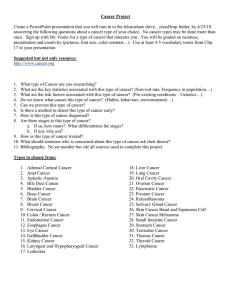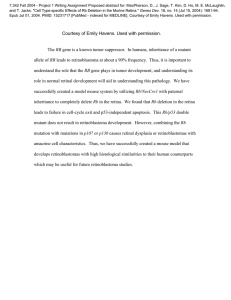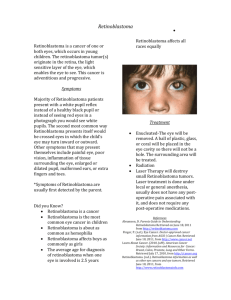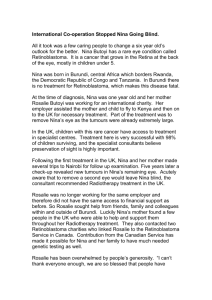Document 14233700
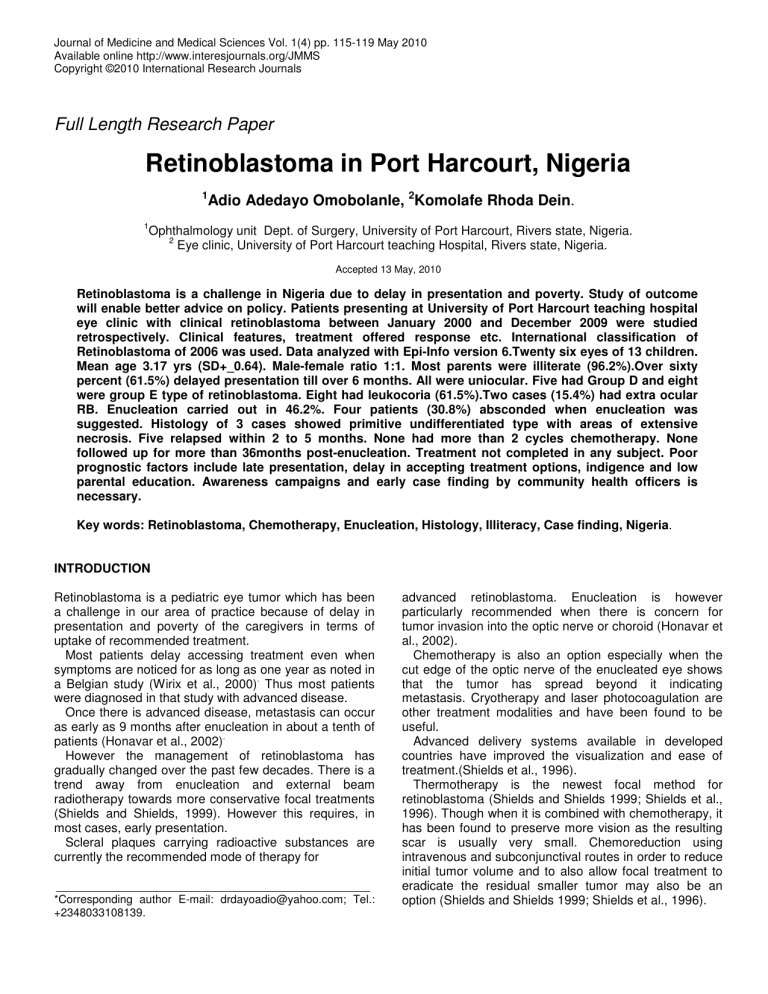
Journal of Medicine and Medical Sciences Vol. 1(4) pp. 115-119 May 2010
Available online http://www.interesjournals.org/JMMS
Copyright ©2010 International Research Journals
Full Length Research Paper
Retinoblastoma in Port Harcourt, Nigeria
1
Adio Adedayo Omobolanle,
2
Komolafe Rhoda Dein
.
1 Ophthalmology unit Dept. of Surgery, University of Port Harcourt, Rivers state, Nigeria.
2 Eye clinic, University of Port Harcourt teaching Hospital, Rivers state, Nigeria.
Accepted 13 May, 2010
Retinoblastoma is a challenge in Nigeria due to delay in presentation and poverty. Study of outcome will enable better advice on policy. Patients presenting at University of Port Harcourt teaching hospital eye clinic with clinical retinoblastoma between January 2000 and December 2009 were studied retrospectively. Clinical features, treatment offered response etc. International classification of
Retinoblastoma of 2006 was used. Data analyzed with Epi-Info version 6.Twenty six eyes of 13 children.
Mean age 3.17 yrs (SD+_0.64). Male-female ratio 1:1. Most parents were illiterate (96.2%).Over sixty percent (61.5%) delayed presentation till over 6 months. All were uniocular. Five had Group D and eight were group E type of retinoblastoma. Eight had leukocoria (61.5%).Two cases (15.4%) had extra ocular
RB. Enucleation carried out in 46.2%. Four patients (30.8%) absconded when enucleation was suggested. Histology of 3 cases showed primitive undifferentiated type with areas of extensive necrosis. Five relapsed within 2 to 5 months. None had more than 2 cycles chemotherapy. None followed up for more than 36months post-enucleation. Treatment not completed in any subject. Poor prognostic factors include late presentation, delay in accepting treatment options, indigence and low parental education. Awareness campaigns and early case finding by community health officers is necessary.
Key words: Retinoblastoma, Chemotherapy, Enucleation, Histology, Illiteracy, Case finding, Nigeria .
INTRODUCTION
Retinoblastoma is a pediatric eye tumor which has been a challenge in our area of practice because of delay in presentation and poverty of the caregivers in terms of uptake of recommended treatment.
Most patients delay accessing treatment even when symptoms are noticed for as long as one year as noted in a Belgian study (Wirix et al., 2000) .
Thus most patients were diagnosed in that study with advanced disease.
Once there is advanced disease, metastasis can occur as early as 9 months after enucleation in about a tenth of patients (Honavar et al., 2002) .
However the management of retinoblastoma has gradually changed over the past few decades. There is a trend away from enucleation and external beam radiotherapy towards more conservative focal treatments
(Shields and Shields, 1999). However this requires, in most cases, early presentation.
Scleral plaques carrying radioactive substances are currently the recommended mode of therapy for
*Corresponding author E-mail: drdayoadio@yahoo.com; Tel.:
+2348033108139.
advanced retinoblastoma.
particularly recommended when there is concern for tumor invasion into the optic nerve or choroid (Honavar et al., 2002).
Enucleation is however
Chemotherapy is also an option especially when the cut edge of the optic nerve of the enucleated eye shows that the tumor has spread beyond it indicating metastasis. Cryotherapy and laser photocoagulation are other treatment modalities and have been found to be useful.
Advanced delivery systems available in developed countries have improved the visualization and ease of treatment.(Shields et al., 1996).
Thermotherapy is the newest focal method for retinoblastoma (Shields and Shields 1999; Shields et al.,
1996). Though when it is combined with chemotherapy, it has been found to preserve more vision as the resulting scar is usually very small. Chemoreduction using intravenous and subconjunctival routes in order to reduce initial tumor volume and to also allow focal treatment to eradicate the residual smaller tumor may also be an option (Shields and Shields 1999; Shields et al., 1996).
116 J. Med. Med. Sci.
In fact the most recent advance in the treatment of retinoblastoma is the use of chemotherapy intravenously to achieve chemoreduction (Shields et al., 2004).The drugs used include vincristine, etoposide and carboplatin given in 6 cycles (Shields et al., 2009). This is then followed by tumor consolidation with focal measures such as thermotherapy, cryotherapy, and plaque radiotherapy.
This strategy provides reduced tumor volume and thus better preservation of vision in some cases (Shields et al., 2004). This also avoids some of the complication of radiotherapy like radiation cataract and macular edema which is common in its use.
Some of these treatment options are however not useful if the patient presents late or cannot fund the treatment costs. There is a paucity of published information on this subject in our locality. This paper is therefore important to study the current pattern of presentation and outcome of patients with this condition in our environment and information obtained from this will also enable us to better advice the health authorities.
This is important as retinoblastoma in more advanced countries has evolved from a deadly childhood cancer to a largely curable cancer in the last 40 years (Lin and
O’Brien, 2009).
Materials and method
Folders of all patients who presented at the University of Port
Harcourt teaching hospital eye clinic with clinical retinoblastoma between the period of January 2000 and December 2009 were included in this study. Patients with other orbital tumors were excluded.
Information retrieved from folders included the demographic characteristics, the presenting symptom(s), the clinical features, treatment offered and response, the histological diagnosis where possible/documented and the follow-up.
The 2006 International Classification of Retinoblastoma based on tumor size, location and associated seeding was used (Shields and
Shields 2006).
This classification is as follows-
Group A=retinoblastoma of up to 3mm in size
Group B=retinoblastoma more than 3mm in size, macular location and mild sub retinal fluid
Group C=retinoblastoma with localized seeds
Group D=retinoblastoma with diffuse seeds
Group E=massive retinoblastoma necessitating enucleation.
This classification was necessary to simplify grouping and to assist in predicting treatment outcome.
All documented histopathology results were noted. Data was calculated using Epi-Info version 6.
Results
Twenty six eyes of 13 children were reviewed over a period of 10 years. Thirteen of the twenty six eyes were found to have retinoblastoma (RB).
Demographics
The age range was between 1year 6 months and 8years.
(Mean age 3.17 yrs SD+_0.64). Male female ratio was
1:1.
Seven of the cases were from Rivers state while three were from Akwa-ibom state and two from Bayelsa state.
One was from Imo state all from the south-south zone of
Nigeria. Most of the parents (96.2%) were indigent with no formal education, ranging from farming, trading, bicycle repairing etc. One parent was however a civil engineer
Presentation
Only one in four (23.1%) presented within 2-3 months of seeing a white reflex. Over sixty percent (61.5%) delayed presentation up to 6 months and 1 year.
One stayed at home for about 16 months. One child presented within 2 days of symptoms however.
All cases were uniocular retinoblastoma with group D
(5cases) and E retinoblastoma (8 cases).
Symptoms at diagnosis were leukocoria in 8 cases
(61.5%), two cases (15.4%) had extra ocular RB with metastasis all over the scalp and lymph nodes in the neck and proptosis.Two patients presented with ocular masquerade syndrome. Three had fungating masses in the affected eye. Strabismus was not a presenting sign.
Treatment
Enucleation was carried out in 46.2% of cases (n=6) all of who presented with group E retinoblastoma. Four patients (30.8% of the patients) were lost to follow up when enucleation was suggested. The optic nerve stump was grossly thickened in two cases. Exenteration was carried out in one case. Chemoreduction alone was carried out in another. Four cases had chemotherapy following enucleation. None had the recommended 6 cycles of chemotherapy though three patients had at least 2 cycles of treatment. One progressed and expired while on chemotherapy. No patient had focal therapy.
One was referred for radiotherapy outside the state.
Histology
Histological analysis was carried out in 3 cases all of which showed Homer –Wrights rosettes and was of the primitive undifferentiated type with areas of extensive necrosis.
Adio and Komolafe 117
Figure 1 . Patient with advanced retinoblastoma being prepped for modified
Exenteration
Follow up
Five presented with relapse between 2 to 5 months following enucleation. Death occurred within 2 months in
2 cases. No patient was observed to develop pinealoblastoma or a second malignant neoplasm at 24
21.5 months and 32.3 months respectively) (Bekibele et al., 2009). months of follow up, however, none of the patients were followed up for more than 36months following enucleation.
Discussion
Classification of Retinoblastoma has evolved over the years and different ones are made to take care of management considerations as newer techniques come up. The latest classification as documented above, found in our review of literature is what we have used for categorizing our patients, as we have found that our patients hardly present early.
Age at presentation
It is widespread knowledge that most children (up to half) who are blind today are blind from causes that could have been treated or preventable (Gilbert and Foster
2003). The mean age of our patients at diagnosis was
3.17 years (38.04 months). This is higher than the reported figures in Caucasian children and even among the cases seen in other geopolitical zones in Nigeria (16-
Presentation
It is observed that early presentation to the eye clinic is not a prominent feature in retinoblastoma in our locality
(See Figure 1).This is the case also in other studies
(Ajaiyeoba et al., 1993, Bekibele et a.,l 2009) ,
(Bekibele et al., 2009)
The ones who manage to present while the tumor is still intraocular and has not metastasized, we have found out, do not generally believe that their ward can have a malignancy which can necessitate removal of the eye and therefore delay in accepting the treatment options offered on time.
They first of all abscond and go to different places including tradomedical and spiritual houses in search of solutions to the health problem while the disease process continues unchecked. So usually the outcome/prognosis is the same as presenting late. Our own patients present even later as demonstrated in this study with majority (61%)presenting up to 6 months after symptoms were noticed as against Bekibele’s study which show that majority
(90%)present one month after symptoms. In our series, no case affected both eyes. A careful dilated examination of both eyes is however necessary to be sure if one or both are involved. In larger series in other zones in Nigeria carried out over a longer period however, bilateral retinoblastoma were encountered in
15-18%, particularly those patients who present at
118 J. Med. Med. Sci. younger age. (Ajaiyeoba 1993, Akang et al.,2000,
Owoeye et al., 2006).
The majority of cases present with leukocoria as in this series where it was the most common type of presentation (Akang et al., 2000). In another study, proptosis was the most common presentation (Owoeye et al., 2006).
Acceptance of treatment
Enucleation is still the most common treatment option as documented in most studies (Owoeye et al., 2006). This was also the commonest option in our study due to late presentation and lack of radiotherapy in the center.
Even when presenting late, very few patients accept to have the eye removed on time before the tumor has spread outside the eyeball. As in this study uptake of enucleation was less than half in patients requiring it. It has been documented that examination of the surgical margin of the optic nerve is important. Optic nerve invasion should be classified as prelaminar, laminar retrolaminar or tumor at surgical margin and the measurement of the depth of invasion should be recorded.(Sastre X et al 2009) .Till date there is only one recorded case over the years in our center of a child( now a teenager) still alive currently after an enucleation was offered and taken up in a timely manner by the care givers with preservation of life. The eyeball removed at the time showed that the optic nerve was free of tumor at the point of transection which gives a good prognosis.
Use of chemotherapy in retinoblastoma has revolutionized treatment.however it is expensive. It is also documented that parents of affected patients are usually low income earners as shown in some studies where financial constraint was a significant factor
(Bekibele et al., 2009).They could hardly afford to neither do investigations nor procure drugs as experienced in our series.
Radiotherapy is also a mainstay of treatment for extraocular retinoblastoma. Since this was put in place in some centers, it has improved the treatment outcome and prognosis of retinoblastoma (Ajaiyeoba et a., 1993) .
It is important to have such equipment in our center as most of our patients prefer to stay in our center and have their complete treatment than travel to other centers they may not be familiar with.
Histology
In the few cases that had histological analysis, Homer-
Wright rosettes were found in all of them rather than the classical Flexner-wintersteiner rosettes found in the majority, in some cases up to 61% (Akang et al., 2000).
Most of the slides showed primitive undifferentiated type with areas of extensive necrosis. This was also documented in a study in another part of Nigeria
(Owoeye et al., 2006).
Follow up
Good follow up is completely lacking as evidenced by so many studies. In our series, no patient within the ten year review was followed up for longer than 3 years.
Treatment was not completed in any of our patients.
Bekibele’s study (Bekibele et al 2009) showed at least some patients (5 out of 26 patients) waited to have their complete treatment.
Conclusion
Retinoblastoma continues to have close to a hundred percent mortality in our locality especially when enucleation is proffered as a treatment modality on account of late presentation. Chemotherapy is also rarely taken advantage of by the caregiver on account of the financial involvement. Poor prognostic factors in the management of this condition therefore include late presentation, delay in accepting treatment options offered, low socioeconomic status and low parental education. Thus widespread patient education and awareness campaigns are necessary. It is important to integrate knowledge of this condition into the curricula of community health officers as they are the ones who work in the interior areas where these patients and their guardians reside to facilitate quick referral.
It is advocated that for the sake of the mostly indigent who this condition often affect that the government establish retinoblastoma centers where treatment can be given free of charge to affected children at an early enough age before metastasis has taken place. The appropriate drugs for chemotherapy should be made available to markedly reduce the mortality rate.
Counseling is necessary to achieve complete understanding of the condition by care givers so as to avail the patient of the benefit of the complete treatment and let them know the implications of defaulting.
REFERENCES
Ajaiyeoba IA, Akang EE, Campbell OB, Olurin IO, Aghadiuno PU
(1993). Retinoblastomas in Ibadan: treatment and prognosis. West
Afr. J. Med. 12(4):223-7.
Akang EE, Ajaiyeoba IA, Campbell OB, Olurin IO, Aghadiuno PU
(2000). Retinoblastomas in Ibadan, Nigeria: II-Clinicopathologic features. West Afr. J. Med.19 (1):6-11.
Bekibele CO, Ayede AI, Asaolu OO, Brown BJ (2009). Retinoblastoma:
The challenges of management in Ibadan, Nigeria. J. Pediatr.
Hematol. Oncol. 31(8):552-555.
Gilbert C, Foster A (2001). Childhood blindness in the context of
VISION 2020--the right to sight Bull. World Health Organ. 79 (3):227-
32. Epub 2003 Jul 7.
Honavar SG, Singh AD, Shields CL, Meadows AT, Demirci H, Cater J,
Shields JA (2002). Postenucleation adjuvant therapy in high-risk retinoblastoma. Arch. Ophthalmol. 120(7):923-931.
Lin P, O’Brien JM 2009). Frontiers in the management of retinoblastoma. Am J Ophthalmol. 148(2):192-8.Epub 2009.
Owoeye JF, Afolayan EA, Ademola –Popoola DS (2006).
Retinoblastoma-a clinico-pathological study in Ilorin, Nigeria. Afr. J.
Health Sci. 13(1-2):117-23.
Sastre X, Chantada GL, Doz F, Wilson MW, de Davila MT, Rodriguez-
Galindo C, Chintagumpala M, Chévez-Barrios P (2009). International
Retinoblastoma Staging Working Group. Proceedings of the consensus meetings from the International Retinoblastoma Staging Working
Group on the pathology guidelines for the examination of enucleated eyes and evaluation of prognostic risk factors in retinoblastoma. Arch.
133(8):1199-202.
Shields CL, Shields JA (1999). Recent developments in the management of retinoblastoma. J Pediatr Ophthalmol Strabismus. 36(1):8-18:quiz
35-6
Shields CL, Meadows AT, Leahey AM, Shields JA (2004). Continuing challenges in the management of retinoblastoma with chemotherapy.
Retina. 24(6):849-62.
Shields CL, Shields JA, De Potter P (1996). New treatment modalities for retinoblastoma. Curr Opin Ophthalmol. 7(3):20-6.
Adio and Komolafe 119
Shields CL, Ramasubramanian A, Thangappan A, Hartzell K, Leahey A,
Meadows AT (2009). Chemoreduction for group E retinoblastoma: comparison of chemoreduction alone versus chemoreduction plus lowdose external radiotherapy in 76 eyes. Ophthalmology. 116(3):544-
551.el.Epub 2009.
Shields CL, Shields JA. Basic understanding of current classification and management of retinoblastoma. Curr. Opin. Ophthalmol. 17(3):228-34.
Wirix M, Parys-Vanginderdeuren R, Casteels I (2000). Delayed diagnosis of retinoblastoma. Bull. Soc. Beige Ophthalmol. ( 278):37-41.
